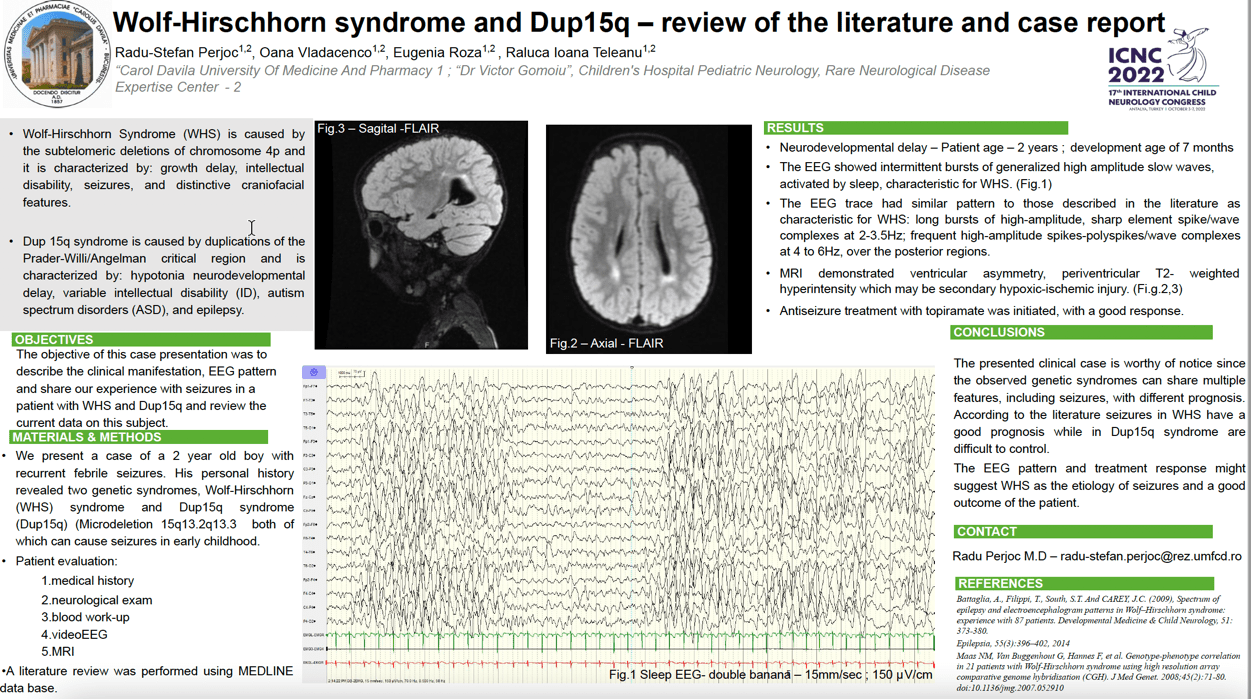Wolf-Hirschhorn syndrome and Dup15q – review of the literature and case report.
Radu Perjoc, Oana Vladâcenco, Raluca Teleanu
Objectives
The Wolf-Hirschhorn Syndrome (WHS) is a rare disease, caused by subtelomeric deletions in the short arm of chromosome 4. The core phenotype of WHS is characterized by: growth delay, intellectual disability, seizures, and distinctive craniofacial features.
The objective of this study was to describe the clinical manifestation, EEG pattern and share our experience with seizures in a patient with WHS and Dup15q and review of the current literature on this subject.
Methods We present a case of a 2 year old boy with recurrent febrile seizures. His personal history revealed two rare genetic syndromes, Wolf-Hirschhorn (WHS) syndrome and Dup15q syndrome (Dup15q), both of which can cause seizures in early childhood. During the hospitalization in our clinic a medical history was taken and the patient underwent a neurological exam, blood work-up, videoEEG(Figure.1) and MRI (Figure.2, Figure.3) A literature review was performed using MEDLINE data base.
Results
The EEG showed intermittent bursts of generalized high amplitude slow waves, activated by sleep, characteristic for WHS. MRI demonstrated ventricular asymmetry, periventricular T2- weighted hyperintensity which may be secondary hypoxic-ischemic injury. Considering the EEG pattern and recurrent seizures antiseizure treatment with Topiramate was initiated.
Conclusions
The presented clinical case is worthy of notice since the observed genetic syndromes can share multiple features, including seizures, with different prognosis. Our patient’s seizures responded well to administration of topiramate.
Keywords: Wolf-Hirschhorn syndrome, genetics, epilepsy
Radu Perjoc
Carol Davila University of Medicine and Pharmacy Bucharest
Romania
Oana Vladâcenco
Dr. Victor Gomoiu Children's Hospital, Carol Davila University of Medicine and Pharmacy Bucharest
Romania
Raluca Teleanu
Dr. Victor Gomoiu Children's Hospital, Carol Davila University of Medicine and Pharmacy Bucharest
Romania
Objectives
The Wolf-Hirschhorn Syndrome (WHS) is a rare disease, caused by subtelomeric deletions in the short arm of chromosome 4. The core phenotype of WHS is characterized by: growth delay, intellectual disability, seizures, and distinctive craniofacial features.
The objective of this study was to describe the clinical manifestation, EEG pattern and share our experience with seizures in a patient with WHS and Dup15q and review of the current literature on this subject.
Methods We present a case of a 2 year old boy with recurrent febrile seizures. His personal history revealed two rare genetic syndromes, Wolf-Hirschhorn (WHS) syndrome and Dup15q syndrome (Dup15q), both of which can cause seizures in early childhood. During the hospitalization in our clinic a medical history was taken and the patient underwent a neurological exam, blood work-up, videoEEG(Figure.1) and MRI (Figure.2, Figure.3) A literature review was performed using MEDLINE data base.
Results
The EEG showed intermittent bursts of generalized high amplitude slow waves, activated by sleep, characteristic for WHS. MRI demonstrated ventricular asymmetry, periventricular T2- weighted hyperintensity which may be secondary hypoxic-ischemic injury. Considering the EEG pattern and recurrent seizures antiseizure treatment with Topiramate was initiated.
Conclusions
The presented clinical case is worthy of notice since the observed genetic syndromes can share multiple features, including seizures, with different prognosis. Our patient’s seizures responded well to administration of topiramate.
Keywords: Wolf-Hirschhorn syndrome, genetics, epilepsy
Radu Perjoc
Carol Davila University of Medicine and Pharmacy Bucharest
Romania
Oana Vladâcenco
Dr. Victor Gomoiu Children's Hospital, Carol Davila University of Medicine and Pharmacy Bucharest
Romania
Raluca Teleanu
Dr. Victor Gomoiu Children's Hospital, Carol Davila University of Medicine and Pharmacy Bucharest
Romania

Radu Perjoc
Carol Davila University of Medicine and Pharmacy Bucharest Romania
Carol Davila University of Medicine and Pharmacy Bucharest Romania